The village of Toropot, in Indonesia, is defined by water. Its residents rely on the sea to fish for a living and to feed their families. Their houses stand on stilts off the coast, and during the day, light hitting the water sparkles up through the floorboards. Beneath the houses, the day’s catch swims around inside nets—nets that sometimes also hold a coveted fish that Shannon Switzer Swanson has been pursuing for almost a year. That fish is the blue tang.
Last summer, Swanson was scouring the Coral Triangle, a region surrounding the Philippines and Indonesia that supplies much of the aquarium trade, for anyone who knew where to find blue tang in the wild. But the azure creature, whose scientific name is Paracanthurus hepatus, was proving elusive. Perhaps the species had been overfished, or maybe damage to its coral homes had pushed the blue tang into new, unidentified waters. Or both.
Swanson had grown deeply curious about the blue tang in late 2015, when the species was gaining attention as the goofy, forgetful title character in the soon-to-be-released animated Disney and Pixar film Finding Dory. With its brilliant cobalt body and golden tail fin, the blue tang is among the most popular aquarium species. Fish experts worried that the sudden burst of fame from the film would trigger a dramatic rise in demand, jeopardizing wild populations.
Swanson, a doctoral student in Stanford’s Emmett Interdisciplinary Program in Environment and Resources, realized that the blue tang dilemma was a perfect example of the complex relationship between marine ecology and people—her subject of study. Fishermen often stun their targets by squirting cyanide into ocean coral, which poisons the reef. Beyond the loss of coral, many of the harvested fish perish in their journey across the world, as they pass through distributor facilities, move from boats to trucks to planes, and spend many hours, if not days, isolated in plastic bags. Yet for the fishermen, who live in impoverished villages with few economic opportunities, the aquarium trade represents a desperately needed source of income. Without the desires of hobbyist collectors, the fishermen’s families would suffer.
Her curiosity about the ocean crystallized into a quest: If Swanson could understand how the blue tang travel from their native habitats to collectors’ aquariums, perhaps she could help craft a strategy to protect not only the exotic blue fish and their coral dwellings, but also the livelihoods of the people who depend on them. If she succeeds, she might then be able to apply her methods to preserving other marine wildlife too.
But first she has to understand the lives of the blue tang harvesters themselves—the inhabitants of the aquatic village of Toropot.
A fisherman named Rasdin walked barefoot along one of Toropot’s walkways, a network of structures lashed together from branches and tree trunks and supported on stilts. He climbed into a rumbling motorboat, bringing onboard diving gear and a fishing spear. It was July of 2016, and Swanson had arrived in Toropot after weeks of exploring the Philippines and Indonesia, following one clue after another as she traveled from Manila to Bali to increasingly remote islands in the Indonesian archipelago. On the island of Banggai, she finally met a blue tang trader. Villagers there approached her with curiosity,pointing the way to a small guesthouse and leading her to one of the two homes with internet access. Word of her arrival spread quickly, and it wasn’t long before a middleman in the aquarium fish trade tapped her on the shoulder and introduced himself as Sarly. They communicated by drawing pictures and consulting a tattered Bahasa-English dictionary, and soon Sarly offered to ferry her on his boat for the final six-hour stretch to meet Rasdin, the harvester who specialized in blue tang.
Once in Toropot, the trio motored from fishing spot to fishing spot. Swanson rode in the front, filming the journey as they drove across the clear, unbroken water. But in the first two places he checked, Rasdin struck out. After three hours of traveling and searching, they pulled into a shallow patch between two rock islands to look once more.Rasdin swiftly entered the water. Swanson scrambled to fit her camera into its waterproof case, wedged her feet into fins, strapped on a weight belt and stepped off the boat. With camera in hand, she pushed her way down the roughly 5 feet to the seafloor.
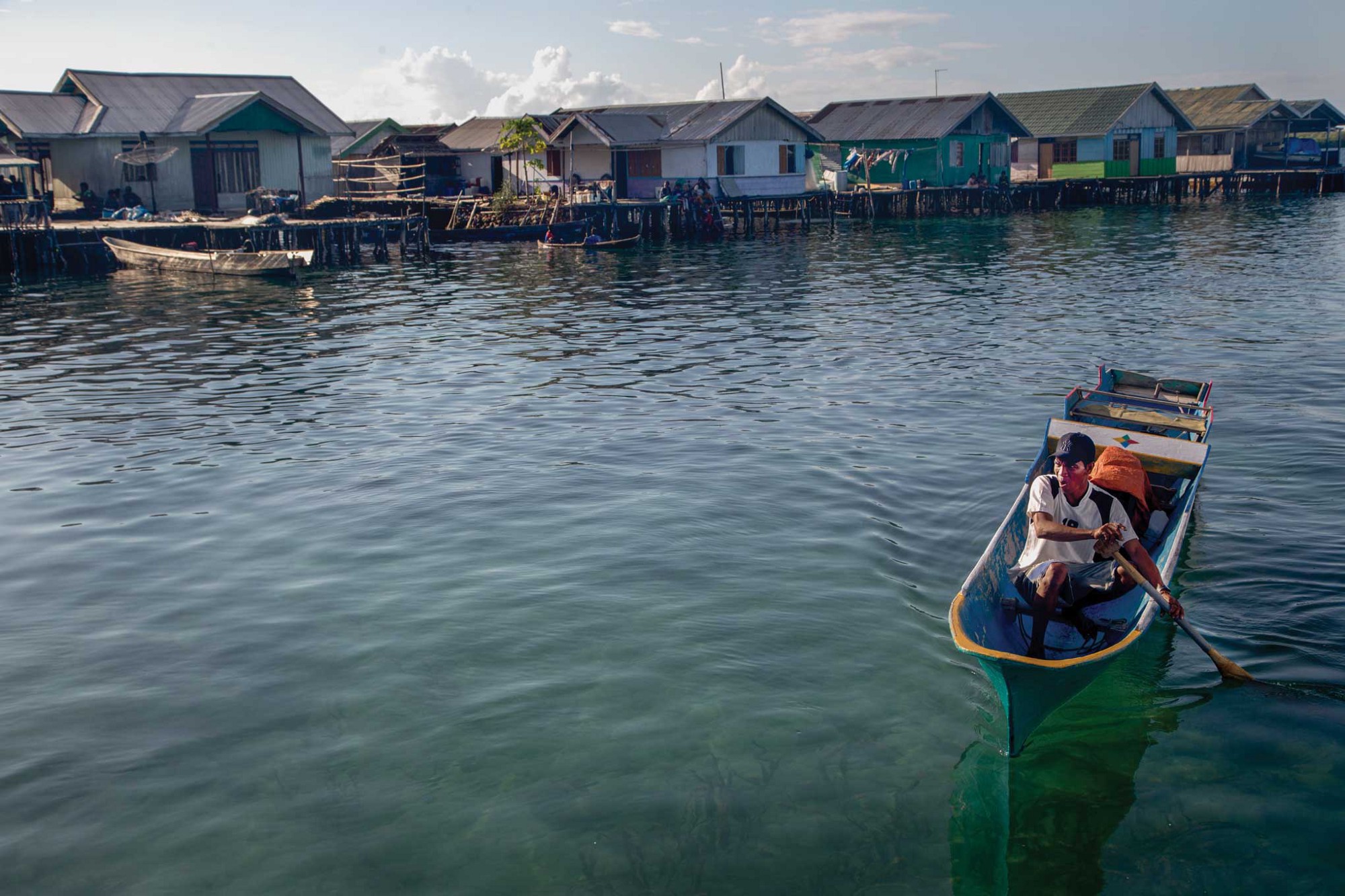
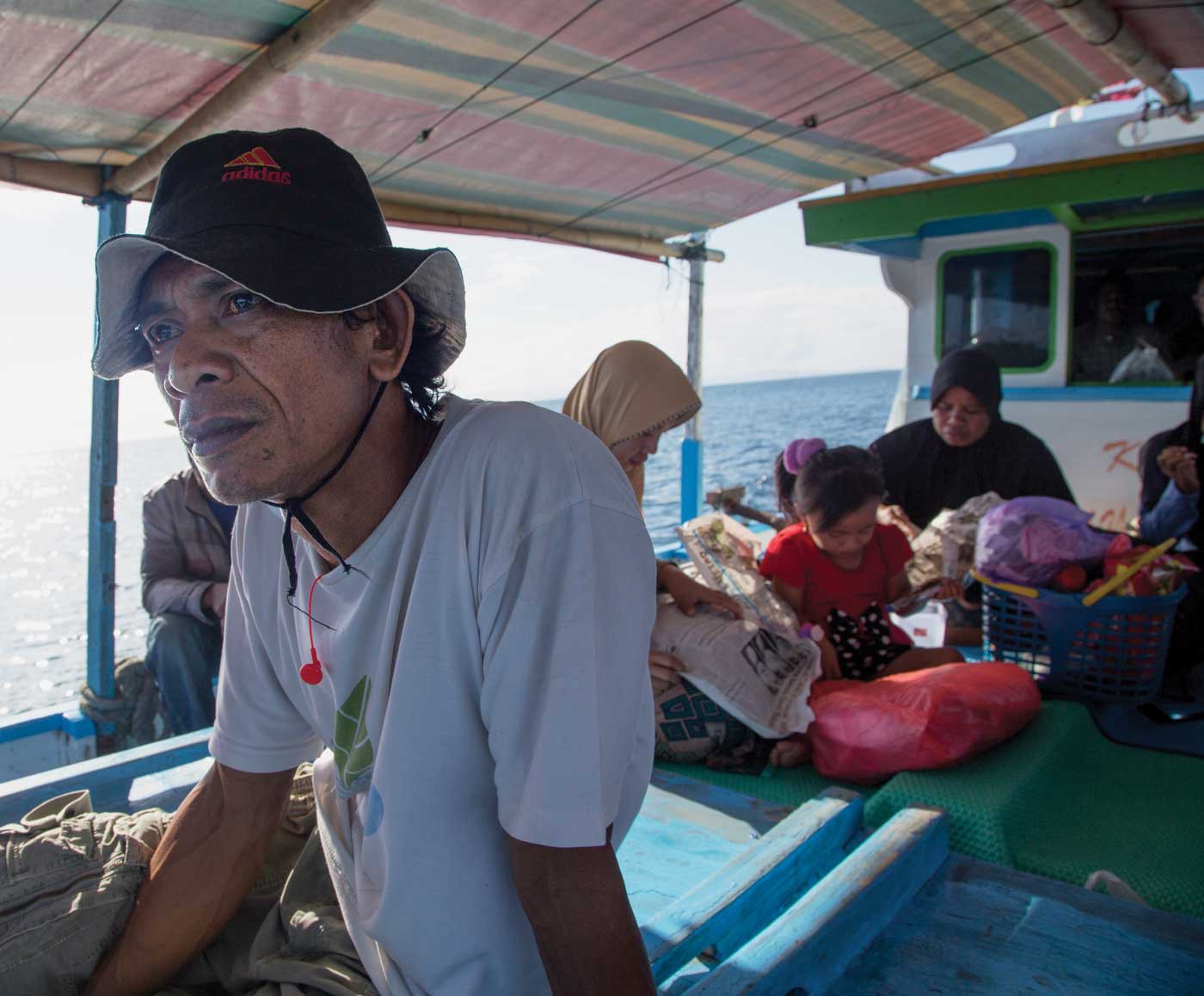 TOROPOT, INDONESIA: Rasdin rows out to welcome Sarly (pictured in bottom photo) and Swanson as they arrive on a ferry from Banggai Island.
TOROPOT, INDONESIA: Rasdin rows out to welcome Sarly (pictured in bottom photo) and Swanson as they arrive on a ferry from Banggai Island.
Rasdin spotted a blue tang and saw it slip into a coral head. He unfurled a few yards of netting over the area. As Swanson filmed, Rasdin reached through an opening in the netting and tapped the coral with the palm of his hand. Then he prodded it with a thin spear. “The blue tang are really shy and wedge themselves in the coral heads and don’t want to come out,” Swanson says. Rasdin gave the coral a few more precise pokes.
Then—suddenly—a tiny blue fish darted out from the coral’s folds. It raced ahead and collided with the side of Rasdin’s net. The fish flitted left and right, its bright yellow tail flashing as it searched for a way out. Rasdin swam over and gently nabbed it between his gloved fingers. The blue tang was his.
“It’s so visceral, seeing that loss of freedom,” Swanson says. “Part of me was so excited for them because this is how they earn their living, and part of me was like, ‘Oh, poor little fish, now he’s going to go be in a tank.’”
That tension between conflicting points of view is what Swanson hopes her work will capture. Sarly told her that two generations earlier the residents of Toropot had lived entirely on boats. Known as sea nomads, they roamed in packs of five or six boats from one fishing area to another, coming to shore only occasionally to trade. Now that they’ve settled into permanent homes, they fish the same areas more consistently. As she got to know Rasdin, his family and his community, Swanson wondered how their change in lifestyle was affecting the ocean habitats they depended on—for example, whether they were depleting their nearby stocks, and if they now had to work longer and harder to earn a living. But to learn more, she’d have to come back, with both a translator and much more time.
30: Estimated years blue tang can live in the wild. Average life span ranges from 8 to 12 years in captivity.
In her travels across the Coral Triangle, she heard repeatedly that the blue tang had become harder to find. Despite its popularity among collectors—it is one of the top 20 species sold in the United States—very little is known about the blue tang, including its prevalence in the wild. But data collected by marine biologist Andrew Rhyne also suggest the fish are in trouble. “The blue tang fisheries cannot be considered healthy,” says Rhyne, an assistant professor at Roger Williams University in Rhode Island and a researcher at the New England Aquarium in Boston.
On a grant from the National Oceanic and Atmospheric Administration, Rhyne combed through shipping invoices from six different years, the most recent being 2011, to create the first data portal on the aquarium trade in the United States. The project determined that about 10 million aquarium fish are imported to the United States each year, of which between 100,000 and 150,000 are blue tang. More than a third of the blue tang came from Indonesia, while almost half were imported from the Philippines.
More recently, Rhyne surveyed Indonesian fishermen on how long they travel to find unspoiled areas. They reported that they now spend one to two weeks on their boats to reach blue tang habitats, whereas the fish used to be nearby. The imperilment of blue tang populations was directly hurting the lives of the fishermen—even as their labor caused some of the problem. “They want to be able to work a certain amount of time, and to be able to feed themselves,” Rhyne says of the fishermen. “If you can incentivize conservation and habitat preservation, that’s a great outcome.”
It’s also not an unreasonable outcome. “In a lot of conservation lingo out there, humans are bad,” says marine ecologist Larry Crowder, one of Swanson’s two PhD advisers at Stanford. “They contaminate the ocean. They destroy the ocean.” But in areas as deeply rural as Toropot, he says, fishermen have a different attitude; they want to sustain the ocean for future generations. In his and Swanson’s view, “we don’t think of people as separated from the marine ecosystem. We think of them as part of it. That’s different from how biologists often think about them.”
Because fishermen are in direct contact with the marine realm, and because they have a personal stake in keeping it healthy, they are uniquely positioned to try out new practices. As Swanson learned more about the lives of small-scale fishermen, “it became almost a social justice issue,” she says. “How is this done more sustainably? How do we manage this not only for the resource itself but for the people who depend on it too?”
Can blue tang be farmed?
The University of Florida Tropical Aquaculture Lab and nonprofit Rising Tide Conservation announced in July 2016 that they had bred the first blue tang in captivity. Twenty-seven of the initial 50,000 eggs had survived. Breeding blue tang is challenging for many reasons, including getting the parent fish to spawn in captivity; managing the tiny eggs; feeding the minuscule larval fish very particular foods; and doing so during their monthlong journey from broadcast (egg release) to reef (or tank bottom).
When I first meet Swanson in person, she has just finished up two hours of surfing at Ocean Beach in San Francisco, a 35-mile drive north from the Stanford campus. It was a gray February day and the waves were washed out, so she and her husband were among the few stalwarts out on their boards. Overhead, hang gliders swooped through the sky like oversized dragonflies.
The midday trip was a short diversion to satisfy a long-standing addiction—a love of surfing that Swanson discovered as an undergrad at UC-Santa Barbara. In college she lived in an apartment overlooking the beach, and she popped out onto her balcony daily to check on the surf. Sometimes she’d get in the water two or three times a day, in between double-majoring in biological sciences and environmental studies. She started learning photography then, too, intrigued by the challenge of shooting her surfer friends underwater.
During her senior year, her father learned of a woman who was planning to sail around the world on her own from San Diego, where Swanson grew up. “He said, ‘Hey, this person sounds a lot like you—you should see what’s up,’” Swanson recalls. She contacted the woman, and ended up joining her expedition for six months as a first mate and an informal photographer. In that time, the pair sailed from San Diego around Mexico, stopping frequently to surf along the way, before arriving in Costa Rica.
There, they happened to park their boat in a bay near some fishermen, who invited them along on an expedition. During their conversations, Swanson says, she learned more about the lives of the fishers, who were struggling to deal with a large commercial fishing boat that had appeared in their waters, which forced them to travel for days to find their own catch. It was through those encounters that her thinking about marine conservation “shifted toward the fishers.”
In the years that followed, she picked up gigs around the world as a photojournalist and a researcher. Assisting other scientists in the field, Swanson collected chimpanzee poop in Uganda and photographed whale sharks for identification in the Seychelles. But after years of working primarily as an itinerant photographer, an occasional science blogger and a part-time researcher, she found herself wishing to engage with science more deeply. “I’d really enjoyed the variety photojournalism had brought, but after seven years I realized I wanted to contribute more expertise.”
So she enrolled in a master’s program at Duke in coastal management. There, she discovered a research technique that has shaped her thinking ever since. She uses what are called visual participatory methods, a type of ethnographic fieldwork that features participants’ own words alongside visual media, with the goal of capturing diverse points of view and using the material to spur debate among the communities under study. Her adviser, Lisa Campbell, a professor of marine affairs and policy, had become a leading proponent of one version of it, called the community voice method.
Campbell had led a pioneering project on endangered turtles in the Turks and Caicos Islands. For it, Campbell interviewed dozens of fishermen, community members and politicians about their perspectives on the turtles. She and her collaborators compiled the footage into a half-hour video and screened it in the fishermen’s communities, sometimes projecting it onto the wall of a grocery store or onto a sheet hung between trees. The films kicked off debates around which of several turtle conservation scenarios might be most realistic and appropriate. “When people see someone they think of as their adversary saying something very close to what they would say, that’s very powerful,” Campbell says. Campbell and her collaborators incorporated the turtle fishers’ perspectives into draft measures that the U.K. territory’s Minister of Environment passed in 2013.
Inspired by her adviser’s success story, Swanson tried out the community voice method in the Philippines, where she interviewed members of a village called Silonay that was restoring its mangroves. With nearby fishing stocks on the decline, villagers were planting mangrove trees in a bid to develop the town into an ecotourism hub while protecting its coastline from getting ravaged by storms—a project conceived by Conservation International, an American nonprofit. Historically, locals had cut down the trees to sell as charcoal. Now the project was hiring villagers to patrol and enforce a ban on logging, while others focused on planting.
Many residents supported the endeavor—after all, it was creating jobs—but it also stirred up tensions. The community group leading the project at times came across as elitist or exclusionary. Some residents believed that everyone in Silonay should belong to the group, while others felt that automatic membership would jeopardize the project’s goals. Swanson edited together a film in which fishermen, shopkeepers, mangrove planters and members of the funding organization each spoke their mind.When she then screened the film in the town church, residents’ initial bruised feelings eventually coalesced into a plan to help nonmembers learn how to get involved and potentially earn income through the restoration. “I really like being able to share results back with a community,” Swanson says. “I do feel very strongly that as a researcher, our job is to not just take our data and be gone, but to invest that back in the community.”
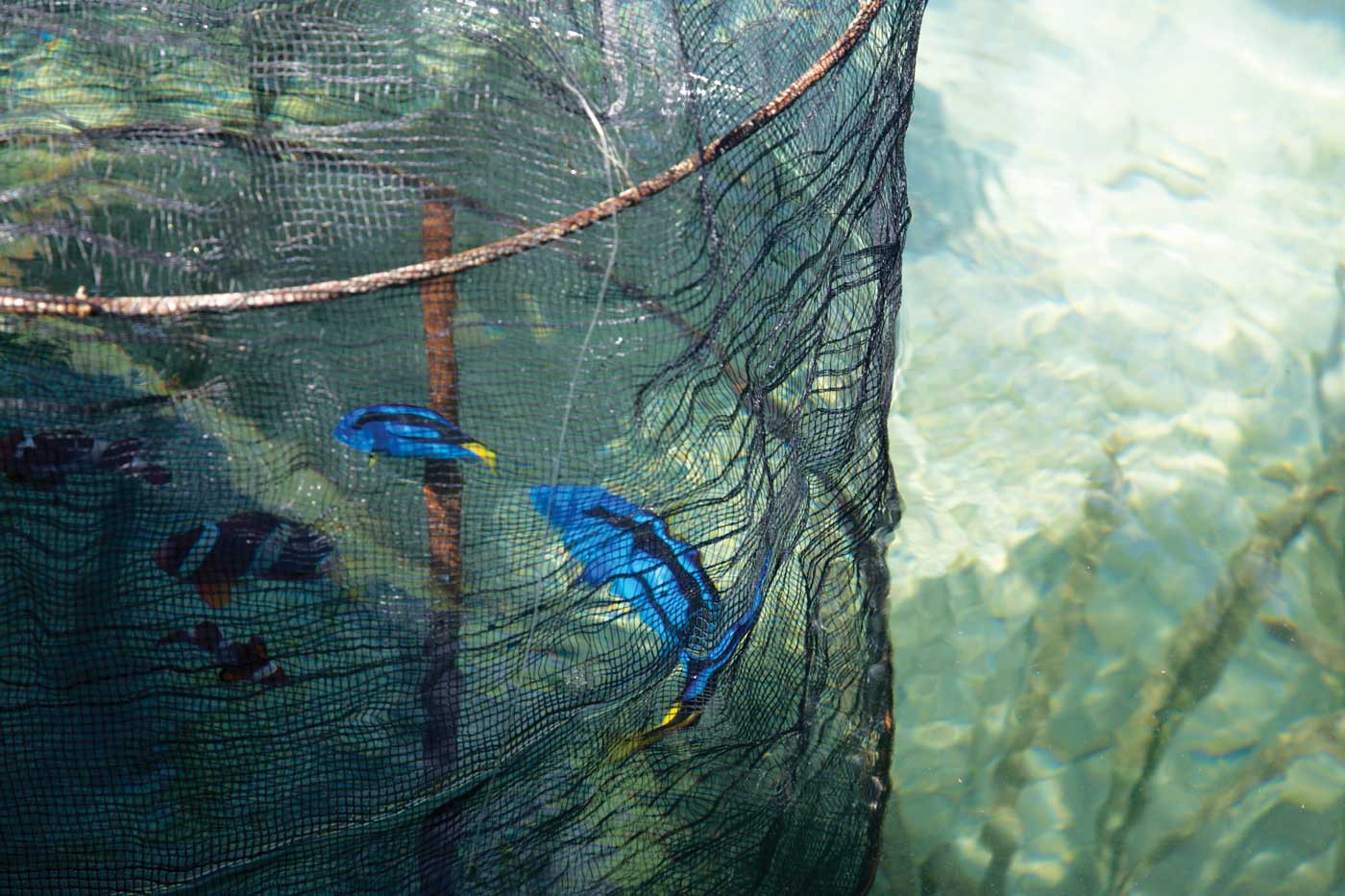

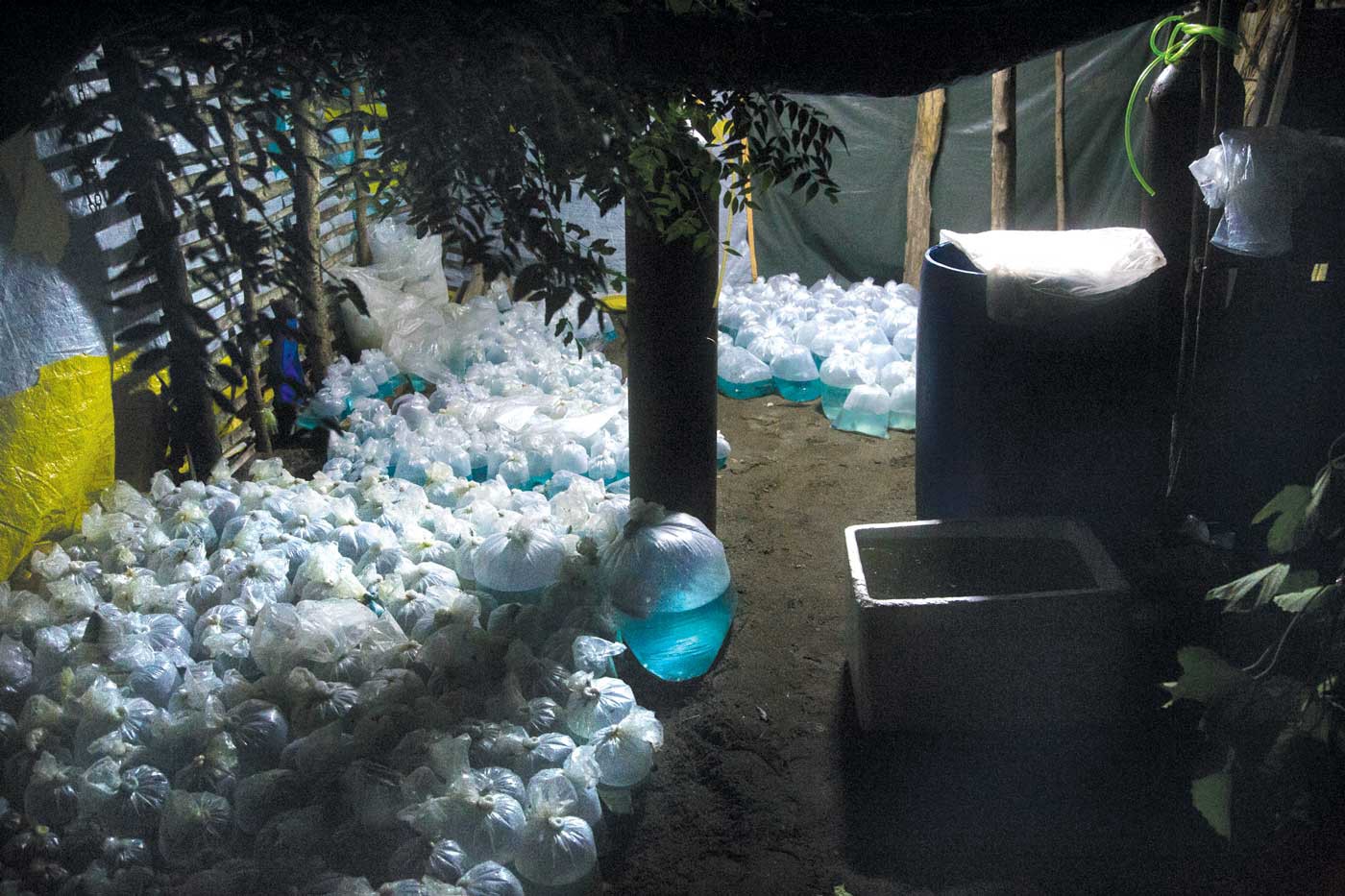
 REEF TO AQUARIUM: From top, the fruits of Rasdin’s labor now rest in a net pen awaiting transport to Banggai and, eventually, Los Angeles; blue tang — these caught off the northern reaches of the Philippines — are transported in plastic bags to a middleman; fish harvested throughout the week off the reefs of Santa Ana in the Philippines await rebagging and reoxygenation before transport to Manila; a worker at Tangjun, a fish exporter in Bali, Indonesia, loads a box of fish onto a truck headed to Ngurah Rai International Airport.
REEF TO AQUARIUM: From top, the fruits of Rasdin’s labor now rest in a net pen awaiting transport to Banggai and, eventually, Los Angeles; blue tang — these caught off the northern reaches of the Philippines — are transported in plastic bags to a middleman; fish harvested throughout the week off the reefs of Santa Ana in the Philippines await rebagging and reoxygenation before transport to Manila; a worker at Tangjun, a fish exporter in Bali, Indonesia, loads a box of fish onto a truck headed to Ngurah Rai International Airport.
These methods, she was realizing, not only shrank the distance between researcher and subject; they also worked to heal the rifts among the subjects themselves. She had found a scientific way to “gain deeper insight into the mind of another individual—to literally see the world the way they do.”
Swanson was hooked. She couldn’t believe her luck at discovering a research technique that blended so many of her interests and talents. “It really did feel like, ‘Oh my god, this is amazing—I can combine everything?’” she says. Now, as a Stanford PhD student, she’s applying this empathy-building approach to a global issue.
For many years, marine conservation efforts have focused on preserving species through regulations that seek to limit the negative impacts of fishing. Yet their success has often been muted. Within the aquarium fish trade, for example, many countries have passed laws banning the use of cyanide in fishing, yet the majority of the aquarium fish that arrive in the United States are estimated to be illegally harvested in this way. Meanwhile, in Indonesia, fishing regulations that do exist are hardly enforced, says Crowder, Swanson’s co-adviser. “In these settings, it never works to be prescriptive,” he says of Indonesia. “In developing countries, government control is basically missing, so what that leads to is working closely with communities.”
Nicole Ardoin, an associate professor in the Graduate School of Education and a senior fellow at the Woods Institute for the Environment, notes that Swanson’s hyperlocal focus fills a long-neglected niche in conservation research. “There’s huge interest and a huge, huge need for understanding the social science component. These marine protected areas do not operate in a vacuum devoid of human contact,” says Ardoin, Swanson’s other co-adviser. “They are always operating in a sociopolitical, cultural and ecological system.” This spring, Swanson is returning to Indonesia for several months to identify more villages involved in harvesting blue tang, and to begin establishing relationships with their inhabitants.
Though the aquarium trade has less of an impact on ocean ecosystems than the food fish trade, the industry is still worth $300 million a year, according to United Nations data. Its higher margins also mean itcan play an outsize role in the lives of fishermen. Blue tang, for example, can sell for between $30 and $200 each, depending on size. Most harvesters receive only a small fraction of that final payout, which gets split among a chain of traders and distributors five or more links long.
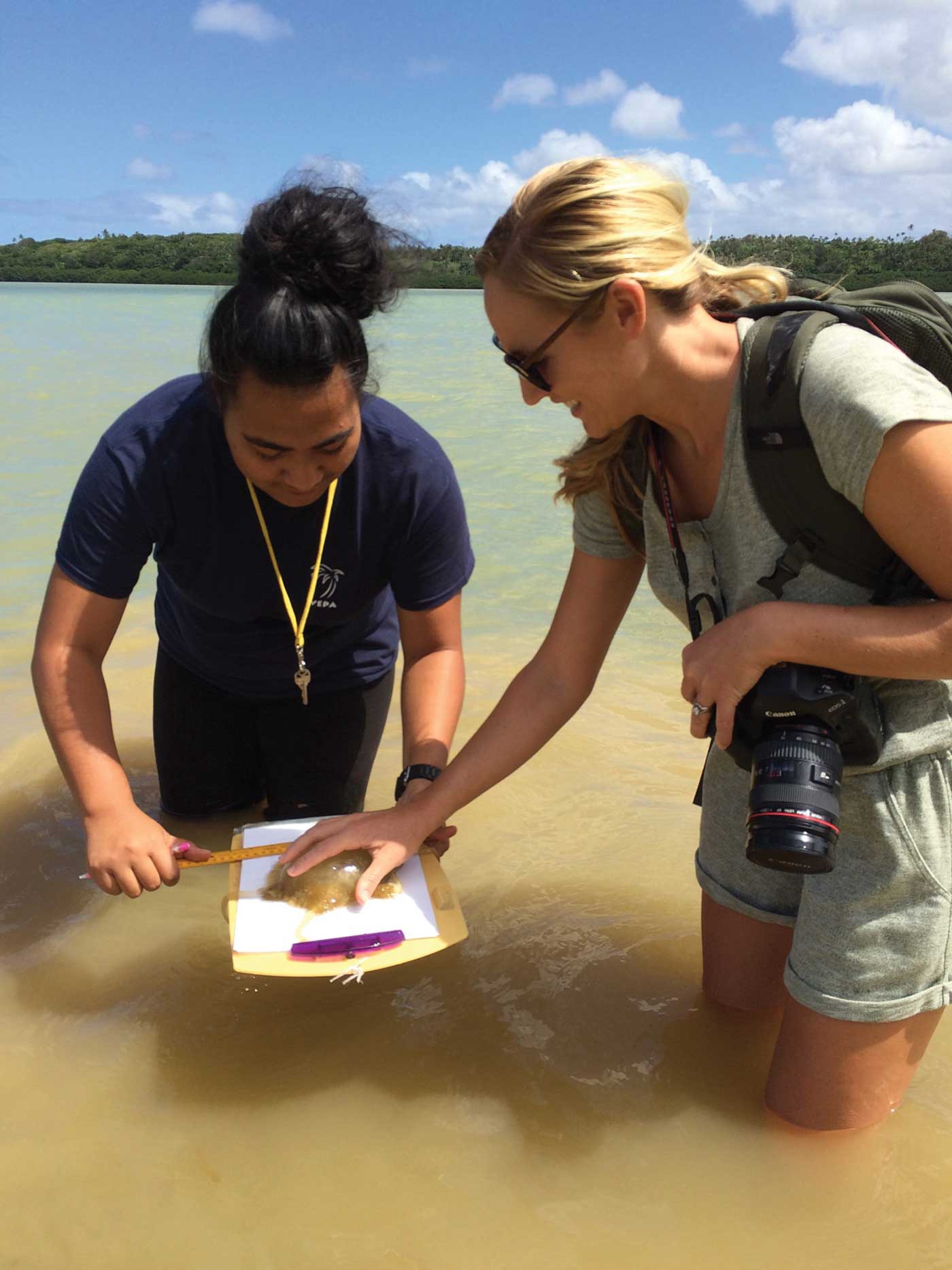 TRIP TO TONGA: While learning about specially managed marine areas last year, Swanson helped a local environmental group measure invertebrates. Photo: Michaela Clemence
TRIP TO TONGA: While learning about specially managed marine areas last year, Swanson helped a local environmental group measure invertebrates. Photo: Michaela Clemence
But they could earn more. Crowder points to a project in Baja California, where an aquarium fishery managed to eliminate several steps in its supply chain while honoring tight controls on the number of fish harvested. The villagers built their own packaging plant, placing the collectible fish in bags of water and saturating the water with oxygen—jobs typically performed by middlemen—before shipping them directly to a wholesale distributor in Los Angeles. Not only did more fish survive this simplified journey, but the harvesters also made significantly more money per fish by offering a higher-value product.
Identifying ways for small-scale fishermen to take control of their own supply chain is just one way research like Swanson’s can help. Knowing more about the trade—like what percentage of fish perish in transit, how mature the fish are when they’re extracted from the ocean, and how different harvesting methods affect their survival—could all generate specific ideas for lessening the harm of the business.
In the short term, Swanson and four collaborators are creating a website to visualize the blue tang supply chain, a project funded by a grant from National Geographic. Later, the team will also release a film about the blue tang’s travels from Indonesia to collectors’ tanks, which they hope to screen at film festivals.
For Swanson, however, it’s the human angle of the aquarium trade that keeps surprising her. One evening in Toropot, she stood on the deck of Rasdin’s stilt house with Sarly, the middleman who had taken her there. Swanson had assumed that distributors and fishermen maintained a strictly business relationship, but she discovered that Sarly didn’t fit that mold. On his home island of Banggai, he had learned from an Indonesian environmental organization more sustainable ways to harvest specimens and had carried that knowledge with him on his trade route, in turn training his fishermen in Toropot.
Standing on the deck and staring up at the stars, he told her, “These people are my family. This is my second home.” The words stuck with Swanson. At least in this fishing village, a more sustainable business was emerging not through quotas or laws, but from friendship.
The Supply Chain
Fisherman
Retrieves blue tang from the ocean.
Local Middleman
Packs fish in oxygenated bags and transports them to a regional hub, or “grows the fish out” in net pens in order to get a higher price from an exporter and have a higher survival rate.
Regional Middleman
If there is a second middleman, he then generally sells fish from many fishers across a large region.
Exporter
Takes orders from importers. Has giant warehouse with hundreds of holding tanks. Reoxygenates and packs fish into boxes to fill orders; sometimes conditions water, depending on quality of the exporter; delivers fish to nearest airport, where they are scanned and inspected and flown to other countries.
Importer
Receives the shipment, has to go through inspections at airport from U.S. Fish and Wildlife Service to ensure contents not on CITES (endangered species) list and to create shipping record, and moves shipment from the airport to its holding facilities.
Wholesaler
Buys fish from importer and fills orders from retailers. Retailer Sells fish to consumers.
Consumer
Places in home aquarium. Dedicated hobbyists have favorite fish and assemble their reef systems with great pride and care.
Sandra Upson, ’03, is a science and technology journalist based in Oakland.



